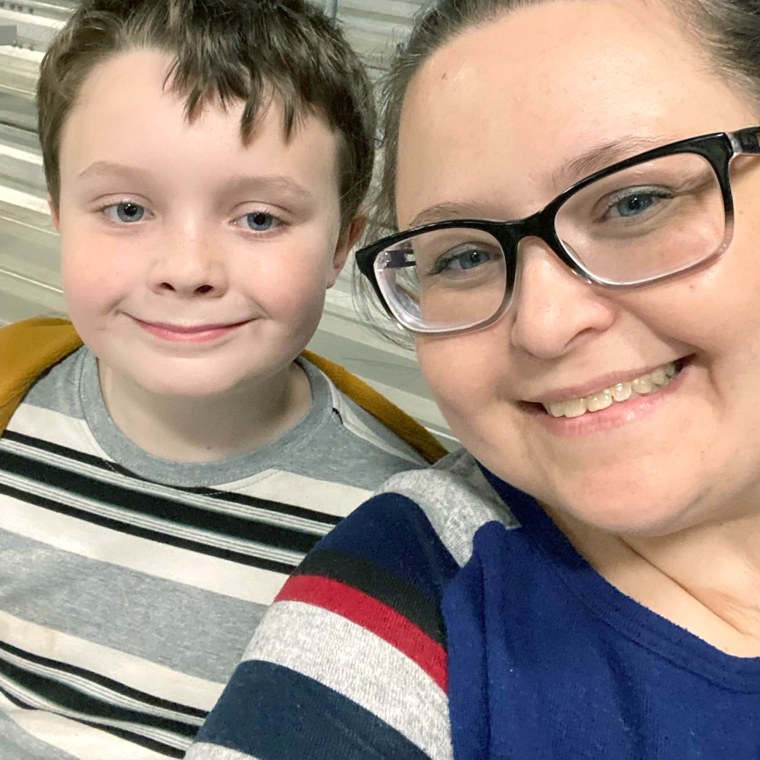This past July, temperatures were sweltering, and Kathy Frost’s son, Norman, 9, started drinking a lot. At first, she thought little of it because everyone needed extra water to cope with the heat. She offhandedly mentioned Norman's thirst to her colleagues at the pharmacy where she works, and they urged her to take it seriously.
“My co-worker said, ‘I have two daughters that are Type 1 diabetics, and their journey started this way. They were thirsty all of the time,’” Frost, 40, of Greencastle, Indiana, tells TODAY.com. “The other pharmacist I worked with said, ‘You have to advocate for your son, and we’re going to find a clinic and you need to take him today to get checked.’”
Frost did and learned Norman had Type 1 diabetes.
“I knew nothing about it,” she says. “You think, 'That’s not going to happen to my kid.'”
Feeling thirsty, urinating more often
Over the summer months, Norman attended day care while Frost worked. The day care workers noticed that Norman drank more than usual and needed to use the bathroom all the time.
“It (was) 90 degrees out,” his mom recalls. “It’s hot out. Of course, he’s going to drink more water.”
One of the day care workers, who has diabetes, encouraged Frost to take Norman to the doctor because thirst is one of the symptoms.

After Frost discussed it with her co-workers at the pharmacy, two agreed with the day care workers assessment. She took Norman to a local clinic, where doctors learned his blood sugar was 457 milligrams. A normal blood sugar range is below 140 milligrams, according to the U.S. Centers for Disease Control and Prevention.
“The doctor was like, ‘You need to go to the ER right now,’” Frost says. “I would have never went (to the clinic) if it didn’t start with the day care telling me, ‘Hey, he’s thirsty.’”
Frost took Norman to Riley Hospital for Children in Indianapolis, where doctors admitted him, gave him fluids and tested to make sure he was not in diabetic ketoacidosis, a potentially life-threatening complication of diabetes. Luckily, he wasn't. Still, Norman stayed in the hospital for two days so they could learn how to manage his Type 1 diabetes.
“The education part was phenomenal. The educator talked (at) Norman's level, asked questions that Norman related to,” she says. “The educator was actually a Type 1 diabetic, too, diagnosed when he was a kid. He showed Norman his Dexcom and insulin.”
A Dexcom is a continuous glucose monitor attached to a person's body to regularly monitor blood sugar levels. After two days and lots of bribes of Lego sets to encourage Norman, they returned home to grapple with blood sugar monitoring and insulin injections on their own.
“I felt like we were leaving with a newborn baby, and we didn’t know what we were doing,” she says. “We’re navigating this new system, but he’s adjusting great.”
Type 1 diabetes
While Type 2 diabetes remains more prevalent in the overall population, Type 1 diabetes is the most common cause of diabetes in children, Dr. Tamara Hannon says.
“Type 1 diabetes is caused by autoimmune destruction of the cells in our pancreas,” Hannon, director of the pediatric diabetes program at Riley Hospital for Children, tells TODAY.com. “There is a trigger of the immune system to actually start to destroy the cells in the pancreas that make insulin.”

“The immune system gets tricked or gets confused,” Hannon explains. “Over time, your body gradually stops making enough insulin to keep blood sugar normal.”
Experts don’t full understand what triggers Type 1 diabetes, which makes it tough for doctors to predict who might get it.
“Chemicals in our environment may be triggers. Different foods have been studied as triggers,” she says. “There may be many things that could be triggers that we don’t know our understand.”
Type 1 diabetes causes an insulin deficiency, so people with it need to receive insulin to survive.
“The treatment is to replace what is missing,” Hannon says. “A person with Type 1 diabetes cannot live without insulin, and the only way we have to give it is by injection under the skin.”
Hannon says that parents need to be aware of symptoms, which include:
- Excessive thirst
- Excessive urination
- Bed wetting
- Fatigue
- Intense hunger without weight gain
“Without insulin, our cells starve because we’re not able to get sugar into the cells, and the sugar provides the energy,” Hannon explains. “When the cells are starving, we need to break down fat in order to stay alive and have energy so weight loss is another (symptom).”
It’s important parents talk to their pediatricians or take their children to the hospital if they notice the symptoms. If left untreated, patients can develop diabetic ketoacidosis — when "acid has built up in the person’s blood so much that they could have a coma and they could die,” Hannon says.
That’s why she encourages people to speak up for their children.
“I would advocate for them to get tested because you can have a situation where the child becomes sicker than they absolutely should,” she says.
Life with diabetes
Norman loves math and helps his mom figure out how much insulin he needs based on the amount of carbohydrates that he eats. While he’s been engaged in caring for himself, he felt ashamed that he had Type 1 diabetes and kept it a secret.
“He is embarrassed about having it,” Frost says “When he first got diagnosed, he wouldn’t tell any of his friends.”

Since he received his Dexcom, he's told his friends and they think it’s cool.
“It made him feel a lot better about the situation, having to have this device on his arm,” she says.
While Norman doesn’t like giving himself insulin shots, he lets his parents give them to him with little fuss. Frost says he’s a “warrior” and is glad that managing his Type 1 diabetes helps him to continue enjoying life.
Frost wanted to share their story to help other families.
“I want people to know the signs,” she says. “I want them to advocate for their children.”
"type" - Google News
November 22, 2023 at 04:11AM
https://ift.tt/xUDbpN6
Mom Speaks Out After Missing Signs Son, 9, Had Type 1 Diabetes - TODAY
"type" - Google News
https://ift.tt/n5argVY
https://ift.tt/sFZPatL
Bagikan Berita Ini














0 Response to "Mom Speaks Out After Missing Signs Son, 9, Had Type 1 Diabetes - TODAY"
Post a Comment